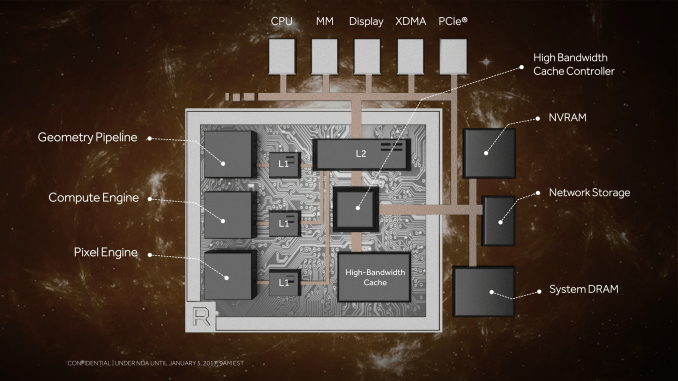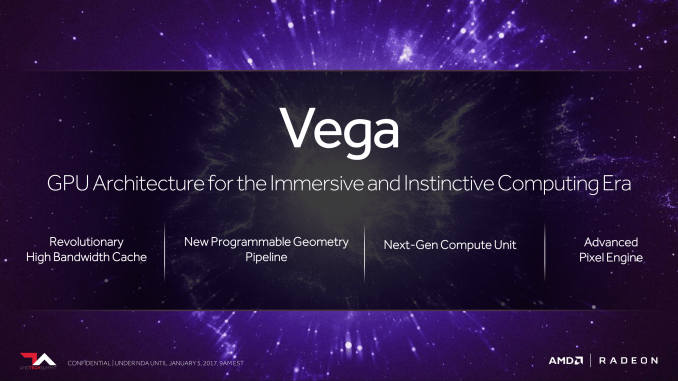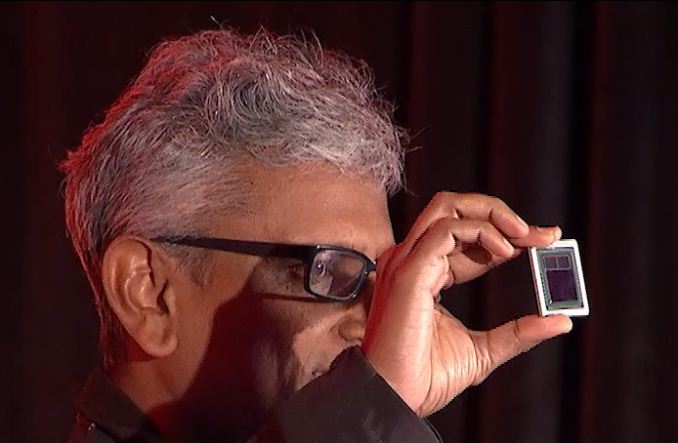The AMD Vega GPU Architecture Teaser: Higher IPC, Tiling, & More, Coming in H1’2017
by Ryan Smith on January 5, 2017 9:00 AM ESTFirst Thoughts: A Peek At What’s To Come
Wrapping things up, while today’s reveal from AMD is only a teaser of what they have been working on over the last few years with Vega, it’s none the less an important one. Based on what we know so far, Vega stands to be the biggest change to AMD’s GPU architecture since GCN 1.0 was released 5 years ago, and the changes to the ALUs, the ROPs, the memory structure, and other aspects of Vega reinforce this notion. To be sure, Vega is not a wholly new architecture – it is clearly a further refinement of GCN – but then this is exactly why GCN was designed to be able to evolve through refinements over a very long period of time.
What we have for now then is a quick look at what’s to come from AMD. There are still many things we don’t know, not the least of which is the actual GPU configurations. But for a teaser it’s enough to show that AMD has been hard at work. It sets the stage for the hardware and marketing ramp-up to come over the next few months.
But for now, let’s close with an image. As I mentioned before, the first Vega has taped out, and Radeon Technology Group’s frontman and Chief Architect, Raja Koduri, has one. The chip was just a few weeks old as of December, and while trying to discern die size may be a little too error-prone, we can see one important detail: 2 HBM2 packages.
Raja and AMD will not tell us what chip we’re looking at – like Polaris, two Vega chips have been confirmed – but either way we are looking at one of them in all its alpha silicon glory. Bearing in mind HBM2’s much greater bandwidth per pin, we could very well be looking at a design for a Fiji-like 512GB/sec of memory bandwidth in the chip Raja holds. And for AMD, that is one more teaser for today to keep attention focused right where they want it: on Vega ahead of its H1’17 launch.



















155 Comments
View All Comments
silverblue - Thursday, January 5, 2017 - link
Formerly Videologic, changed in 1999 to Imagination Technologies.I had a Kyro II. The first Kyro was clocked at a mere 115MHz for both core and memory, but Kyro II was a whole 60MHz faster. It really worked well in UT when paired with my XP 1700+. :) There was a Kyro II SE with 200MHz clocks but was as rare as rocking horse excrement. I was also very excited about its supposed TnL, DDR-powered successor, but it never launched, which meant bye-bye on the desktop for PowerVR, rather than the bloody nose that ATi and NVIDIA deserved at that time.
wumpus - Friday, January 6, 2017 - link
If my poor memory is remotely accurate (don't bet on it), the chip to run Unreal Tournament was the S3 chip (probably the last they made). Not sure if the "TnL" it supposedly had was fraudulent or defective, but the texture compression (probably only used in Unreal Tournament before S3 died and it became a standard feature) gave the S3 the best visuals in the game.I know I had one of those boards (simply because it was cheap, long after its day) but can't remember how it performed on Unreal Tournament (I may not have bothered putting windows on that box. In those days the best way to connect windows to the internet was to connect a Linux machine to a DSL modem, then connect windows to Linux. Connecting Windows to DSL was asking to get it to blindly reset all your configuration files at random intervals).
BrokenCrayons - Friday, January 6, 2017 - link
You're probably thinking about S3's Savage video card series with the S3 MeTaL API. It's been ages, but I'm pretty sure UT supported MeTaL out of the box. Epic was pretty good about that back when there was a plethora of competing APIs before we settled into DirectX and OpenGL. When I tried to diversify my PC shop by adding an after-hours LAN arcade, we used those graphics cards because they were good for the multiplayer stuff we wanted to run. I do recall they were a bit glitchy under Descent Freespace. There were artifacts around ship engine glow effects and I think it was due to poor DirectX suport, but don't quote me on that, it's been years.silverblue - Friday, January 6, 2017 - link
Yeah, MeTaL was there at retail, as long as you installed the texture pack from the second disc. I had a Savage 4 (Diamond S540) which worked flawlessly... until I flashed the BIOS one day, thereafter it would hang during every session at a random point, thus requiring a reboot. That was a stupid idea, especially considering it looked excellent. Luckily, somebody got the OpenGL mode to work with those textures.I believe the T&L on the Savage 2000 was unfit for purpose; it was broken in hardware so you couldn't coax its true performance out.
silverblue - Friday, January 6, 2017 - link
Sorry, to clarify, you could use MeTaL without the texture pack, but what would be the point? :)Threska - Friday, January 6, 2017 - link
And for the time it was a very nice card. Shame Kyro didn't take offhttps://en.wikipedia.org/wiki/PowerVR
eldakka - Friday, January 6, 2017 - link
I always liked the infinite planes concept (no polygons!) of the PowerVR 1 series. I remember being disappointed at the time, and still am, that infinite planes never caught on. The entire paradigm gave many operations 'for free' that today require a lot of hardware and software support to implement.Threska - Saturday, January 7, 2017 - link
Could have been a patent issue.tarqsharq - Friday, January 6, 2017 - link
I remembering excitedly reading about TBR with an article about the Kyro II on this very website oh so many years ago like you're saying. http://www.anandtech.com/show/735Funny enough, it didn't do well in the market because the APIs at the time weren't very flexible and required a lot of tweaking to it working in each engine pretty much.
The games that it did work well in, the card punched WAY above its cost bracket if I remember correctly.
Jtaylor1986 - Thursday, January 5, 2017 - link
This design has probably been in the works for 3+ years. Nvidia just beat them to market it had nothing to do with David Kanter.